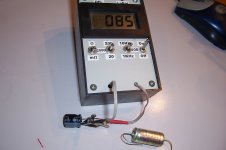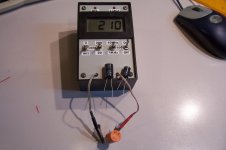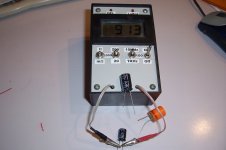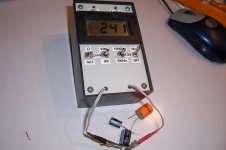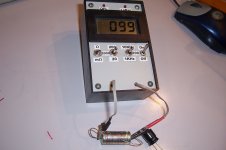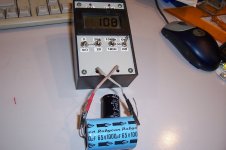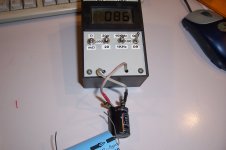I've often wondered what the specs were like on the caps that come out of older gear, particularly the early 80s (those emerald Nichicon Muse, plastic-cased gold/black Nichicons, Black Gates, etc), especially given the larger physical sizes.
Just curious on exactly how much the ripple current ratings have improved over time, as I've never seen numerical data apart from the labeled capacitance / voltage and measured ESR many years on.
Appreciate any documentation if anyone has any!
Just curious on exactly how much the ripple current ratings have improved over time, as I've never seen numerical data apart from the labeled capacitance / voltage and measured ESR many years on.
Appreciate any documentation if anyone has any!
Electronic datasheets often won't have a date on them (just checked my collection from circa late 1990's). Switchmodes spurred on new models during the 1990's. You may find Philips databooks on-line - they came out in individual product groups, so there is likely an electrolytic cap book (there may be one at work, but I can't look for a while).
Was your interest in ripple for mains frequency? Not sure when the datasheets started to include ripple current multiplier tables for different frequencies than mains.
Was your interest in ripple for mains frequency? Not sure when the datasheets started to include ripple current multiplier tables for different frequencies than mains.
Yeah just for mains frequency or 100Hz, or really any data at all.
Modern sheets include frequency multipliers for ripple so I'm sure you could do a rough extrapolation if needed.
These days there's per-model datasheets for virtually all capacitors, and the same seem to exist for transistors dating back to the 70s and 80s at least, but I've never seen much data on electrolytics from that era.
Just curious exactly how much things have improved - not that I doubt they have - but it'd be cool to see the values.
Modern sheets include frequency multipliers for ripple so I'm sure you could do a rough extrapolation if needed.
These days there's per-model datasheets for virtually all capacitors, and the same seem to exist for transistors dating back to the 70s and 80s at least, but I've never seen much data on electrolytics from that era.
Just curious exactly how much things have improved - not that I doubt they have - but it'd be cool to see the values.
You would be surprised, and probably disappointed: things did change: the volume of modern E-caps has shrunk considerably for a given C*V product, their weight has decreased, the max operating temperature has increased routinely to 105°C and sometimes to 115 or 125°C, or even more, from 85°C or 70°C, sometimes 65°C in the 60's.Just curious exactly how much things have improved - not that I doubt they have - but it'd be cool to see the values.
There are also other aspects: the voltage surge capability has been seriously curtailed: older caps withstood 1.5x Vnom for 1 minute or so, but I am not sure modern ones could hold for a single second.
Their actual, useful life has also been drastically reduced.
I am talking about decent caps, made by reputable manufacturers, mainly European and Japanese: Siemens, Nichicon, etc.
There were also dodgier brands, like F&T, many British, Italian or US manufacturers.
You could think that modern caps have better characteristics: ESR, ESL, ripple current, etc.
We can put this to the test: I have a vast stash of NOS caps, and also modern ones for comparison.
For example, here is a 220µF/16V from Siemens, type GSF in a thermoset case, made in the early 70's.
As you can see, its esr is 210mΩ.
Now, let's measure a contemporary Rubycon of the same value (type YXM):
The esr is 913mΩ.
To arrive at a comparable value, we need to go to the 50V type
Another example: this time a 1000µ/16V, first from Nichicon (type HE(M)):
The esr is 85mΩ
Then, a Siemens made in 1974. The comparison is unfair, because it is an axial type, which means that by construction, the esr is increased by ~50% due to the folded-ribbon cathode connection
Yet, at 99mΩ, it's not too far off.
Now, a 1000µF/65V, a huge dinosaur from the sixties, made by Rubycon: 108mΩ
Its opponent is an Elna LP5, and here again the comparison is somewhat unfair, because it is a 100V part and radial:
Yet, 86mΩ esr is not much lower.
What conclusion can be drawn? In general, older caps will have a lower esr compared to modern parts. This means that their ripple current limit will be higher, because less heat is generated, and is better evacuated, thanks to the larger case size.
Modern caps have electrolytes capable of withstanding high temperatures, but since there are no free lunches in engineering, they have a higher resistivity @25°C, and they need to heat up to attain good performances, a bit like CFL lamps, but unfortunately, heat is the ennemy of durability...
Of course, there are now other technologies like OSCON and similar having vastly superior performances, but wet aluminum didn't progress that much, except for size
Attachments
Last edited:
I also have similar experience with the ESR and would like to add that the actual capacitance on modern ones from Japanese manufacturers tend to be lower than their nominal values but still within the 20% spec. Older caps have wider tolerance like -50%/+100% if I remember correctly and old capacitors that were not stressed in a 40+ year gear measured higher capacitance. I take this into account when rebuiling old equipment or else you end up with higher power supply ripple!
You would be surprised, and probably disappointed: things did change: the volume of modern E-caps has shrunk considerably for a given C*V product, their weight has decreased, the max operating temperature has increased routinely to 105°C and sometimes to 115 or 125°C, or even more, from 85°C or 70°C, sometimes 65°C in the 60's.
There are also other aspects: the voltage surge capability has been seriously curtailed: older caps withstood 1.5x Vnom for 1 minute or so, but I am not sure modern ones could hold for a single second.
Their actual, useful life has also been drastically reduced.
Of course, there are now other technologies like OSCON and similar having vastly superior performances, but wet aluminum didn't progress that much, except for size
Greatly appreciate your reply, this is exactly what I wondered. I've certainly measured lower ESR on older parts, and often even the capacitance of new parts is closer to -20% which is pretty irritating (exactly like ej25awd, I've often been jumping to the next higher capacitance value, on top of increasing voltage rating).
Do you have any further thoughts on OSCON / solid polymer types? Are there any applications / circuit areas where they wouldn't be preferable to regular wet caps, if cost isn't a concern and over-voltage isn't likely? I've been using them often with no problems to speak of, but no doubt you have more experience / data.
I see no restriction to the use of solid polymer caps: they are close to perfection on almost every aspect.Do you have any further thoughts on OSCON / solid polymer types? Are there any applications / circuit areas where they wouldn't be preferable to regular wet caps, if cost isn't a concern and over-voltage isn't likely? I've been using them often with no problems to speak of, but no doubt you have more experience / data.
The only superiority of wet caps is their ability to heal after a traumatic event (within reason, of course).
I see no restriction to the use of solid polymer caps: they are close to perfection on almost every aspect.
The only superiority of wet caps is their ability to heal after a traumatic event (within reason, of course).
Thanks, I suspected as much.
Another question if you don't mind - what do you think of the recent "electric power steering" capacitor lines, eg. Chemicon GPD / GVD and Nichicon UBY?
They have low ESR and high ripple (and 125-135*C ratedg), with an apparent aim to reduce ESR at low temperatures (they provide data at -40*C and 20*C):
https://www.chemi-con.co.jp/e/company/pdf/20120925-2.pdf
(see 2nd page)
Datasheets:
GPD: http://www.mouser.com/pdfdocs/GPDDatasheet.PDF
GVD: http://www.mouser.com/ds/2/420/-775767.pdf
UBY: http://www.nichicon.co.jp/english/products/pdfs/UBY_e.pdf
Is there a catch I'm missing? LC is a little higher (0.03CV) than some "audio" capacitors, but comparable to Nichicon PW still.
Sidenote: there are more values available in the Chemicon lineup, especially in higher V ratings.
I've noticed that some solid polymer caps (Oscon) have a failure mode where their leakage current slowly climbs to catastrophic levels, despite never exceeding the faceplate voltage level or asking it to handle ripple current of any significant magnitude.
This need for de-rating, combined with the difficulty of finding high faceplate voltage ratings makes them hard to use for higher voltage (>15V) uses. They're fantastic for CPU core voltage buck regulators handling huge HF ripple currents, but for standard HV linear circuits, they seem more annoying to handle than a standard wet Al electrolytic.
This need for de-rating, combined with the difficulty of finding high faceplate voltage ratings makes them hard to use for higher voltage (>15V) uses. They're fantastic for CPU core voltage buck regulators handling huge HF ripple currents, but for standard HV linear circuits, they seem more annoying to handle than a standard wet Al electrolytic.
I wasn't aware of these series, thanks for the pointers.Thanks, I suspected as much.
Another question if you don't mind - what do you think of the recent "electric power steering" capacitor lines, eg. Chemicon GPD / GVD and Nichicon UBY?
Is there a catch I'm missing? LC is a little higher (0.03CV) than some "audio" capacitors, but comparable to Nichicon PW still.
They look like a move in the right direction. Time will tell if there is a snag somewhere, but they are reputable manufacturers, which is reassuring
Some (but not all) may have a highish leakage, but anyway using them for coupling looks like huge overkill, because the low esr etc. is completely wasted. For bypass applications, they should shine, except perhaps in very marginal casesSolid polymer electrolytics have VERY high leakage current. It is not suitable for audio AC bypass and coupling duties unless high output DC offset and noisy volume controls is your thing.
I have never encountered such a case, yet we use them by the 10,000's, but it's probably something specific to one manufacturerI've noticed that some solid polymer caps (Oscon) have a failure mode where their leakage current slowly climbs to catastrophic levels, despite never exceeding the faceplate voltage level or asking it to handle ripple current of any significant magnitude.
They are not suited to high voltage applications (so far), but Al wet caps are still the only ones reaching 450V.This need for de-rating, combined with the difficulty of finding high faceplate voltage ratings makes them hard to use for higher voltage (>15V) uses. They're fantastic for CPU core voltage buck regulators handling huge HF ripple currents, but for standard HV linear circuits, they seem more annoying to handle than a standard wet Al electrolytic.
Even wet tantalum are limited in this respect
- Status
- This old topic is closed. If you want to reopen this topic, contact a moderator using the "Report Post" button.
- Home
- Design & Build
- Parts
- Datasheets for 70s/80s electrolytics? (for ripple values etc)
